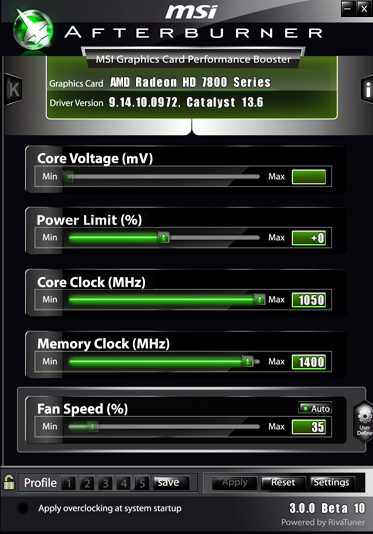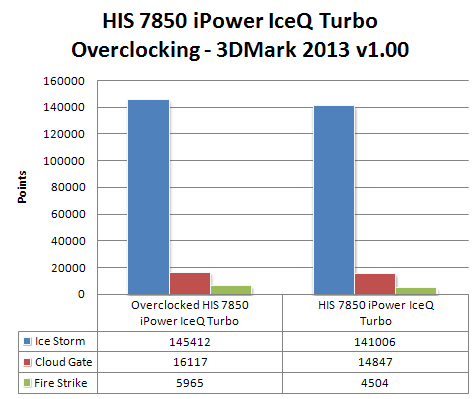HIS Radeon HD 7850 4GB iPower IceQ Turbo, Radeon HD 7950 IceQ X2
10. Overclocking
Review Pages
2. Meet the HIS Radeon HD 7850 4GB iPower IceQ Turbo
3. Meet the HIS Radeon HD 7950 IceQ X2
4. Test setup
5. DirectX 11: 3D Mark 11, 3DMark 2013
6. DirectX 11: Crysis 3, Hitman Absolution
7. DirectX 11: Far Cry 3, Final Fantasy
8. DirectX 11: Alien Vs Predator, Sleeping Dogs
9. DirectX 11: Tomb Rider, Sniper Elite V2
10. Overclocking
11. Final words
Overclocking the HIS 7850 iPower IceQ Turbo
For our overclocking tests we used the latest MSI AfterBurner utility which also allows you to unlock the card's voltages for further tweaking. Here are the results:
| Original clock | Overclocked |
| Core Clock: 1000MHz | Core Clock: 1050MHz |
| Memory Clock: 1200MHz | Memory Clock: 1400MHz |


The HIS Radeon HD 7850 4GB iPower IceQ Turbo has been BIOS locked at a maximum of 1050 MHz so it's hard to take it any further. By increasing the power limit by
20% and applying 1450 MHz on the memory clock, you may get a little higher. But have in mind that you do it at your own risk.
Below you see the actual in-game performance you may experience after overclocking the card with the 3D Mark 2013 benchmark:

- Overclocking the HIS 7950 iPower IceQ Turbo
Again, we used the MSI AfterBurner utility. Here are the results:
| Original clock | Overclocked |
| Core Clock: 950 MHz | Core Clock: 1150MHz |
| Memory Clock: 1250 MHz | Memory Clock: 1350MHz |
The HIS R7950 is easy to tweak and you will not be disappointed by the results. Coming from a 950 MHz factory overclocked, we had the card running stable at 1150MHz by increasing the power limiter and setting the fan RPM at 40%:


Above, 3DMark 11. There is an additional bump in this GPU limited software.
Below you see the average FPS you get after overclocking both the HIS 7850 and 7950 cards. It is obvious that the 7950 offers more overclocking headroom and it make more sense to tweak it:

